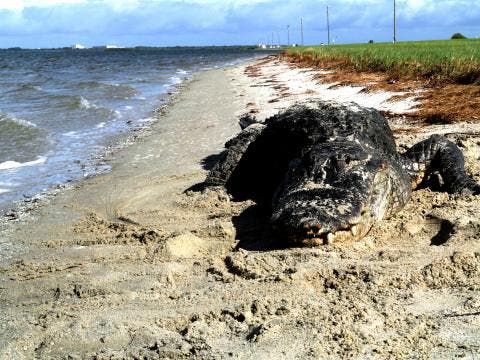
Recently, more and more peculiar sightings of predators have been reported in places they’re not traditionally associated with. For instance, alligators have been spotted enjoying the sun on Florida beaches while killer whales have been seen swimming freely in freshwater rivers. At first glance, these shocking occurrences can be explained by successful conservation efforts that have improved predator populations — but there’s much more to it.
In a new study, researchers have found that as predator numbers rebounded, they’ve actually reclaiming what was rightfully theirs, reconquering habitats they called home before human activity drove them out.
“We can no longer chock up a large alligator on a beach or coral reef as an aberrant sighting,” said Brian Silliman, Rachel Carson Associate Professor of Marine Conservation Biology at Duke’s Nicholas School of the Environment.
“It’s not an outlier or short-term blip. It’s the old norm, the way it used to be before we pushed these species onto their last legs in hard-to-reach refuges. Now, they are returning.”
Home away from home
Silliman was once in a saltmarsh studying crabs and snails when he came across an alligator, which is a freshwater specialist. He was utterly shocked but as he learned of other similar sightings, the biologist spotted a pattern. Soon, it was clear that the alligators weren’t alone and that other apex predators, both on land and in water, were unconventionally moving into new territories.
By processing data from scientific studies and government reports, Silliman and colleagues learned that large predators were spotted into other territories. Examples include the movements of orangutans into disturbed forests, river otters into marine wetlands, wolves and coyotes onto beaches and rocky shores, and grey, harbor, and harp seals from the Arctic into subtropical waters. These places were actually part of the predators’ original habitat but human intervention drove them out, Silliman says.
“The assumption, widely reinforced in both the scientific and popular media, is that these animals live where they live because they are habitat specialists. Alligators love swamps; sea otters do best in saltwater kelp forests; orangutans need undisturbed forests; marine mammals prefer polar waters. But this is based on studies and observations made while these populations were in sharp decline. Now that they are rebounding, they’re surprising us by demonstrating how adaptable and cosmopolitan they really are,” Silliman said, who published the findings in the journal Current Biology.
Check out this alligator on the beach in St. Joseph Bay today! From: S. Jones Tolley pic.twitter.com/eMQo6auaRP
— Chris Smith (@smithwjhg) May 6, 2018
The findings are good news. They suggest that large predators are more adaptable than previously thought. For instance, up to 90 percent of the diets of alligators found in seagrass or mangrove ecosystems consisted of stingrays, sharks, shrimp, and other marine species. As climate change intensifies, it’s important to know that some predators are more resilient than previously thought in order to plan conservation accordingly.
Climate change, for instance, threatens kelp forests which sea otters love but the animals are flexible enough to occupy estuaries which lack kelp forests. Moreover, the movement of large predators back into their historic ranges can be beneficial for ecosystems. The introduction of sea otters to estuarine seagrass beds helps protect the beds from being smothered by epiphytic algae that feed on excess nutrient runoff from inland farms and cities.
“It tells us these species can thrive in a much greater variety of habitats. Sea otters, for instance, can adapt and thrive if we introduce them into estuaries that don’t have kelp forests. So even if kelp forests disappear because of climate change, the otters won’t,” Silliman said. “Maybe they can even live in rivers. We will find out soon enough.”






